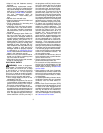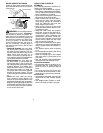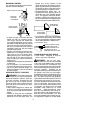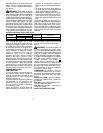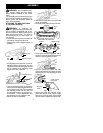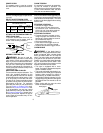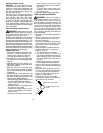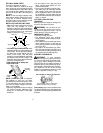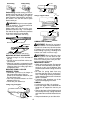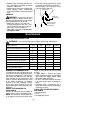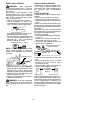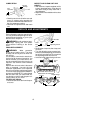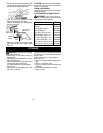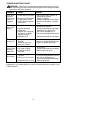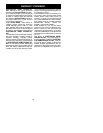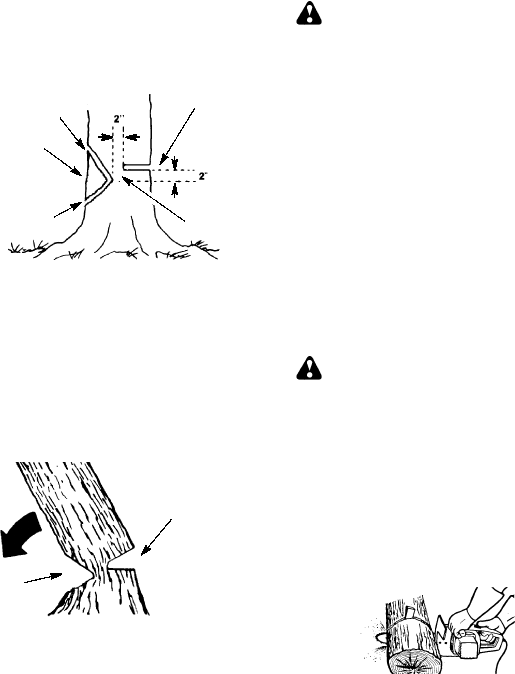
11
FELLING LARGE TREES
(6 inches in diameter or larger)
The notch method is used to fell large
trees. A notch is cut on the side of the tree
in th edesired direc t io nof fall.After afelling
cut is made on the opposite side of tree,
the tre e will tend to fall in the directio n of
the notch.
NOTE: If tree has large buttress roots,
removethem before making thenotch. If
using saw to remove buttress roots,
keep saw chain from contacting ground
to prevent dulling of the chain.
NOTCH CUT AND FELLING TREE
S
Make notch cut by cutting the top of the
notch first. Cut through
1/3
of the
diameter of the tree. Next complete the
notc h b ycutting thebottom. Seeillustra-
tion. Once the notch is cut, remove the
wedge of wood from tree.
Notch
First cut
Second cut
Final cut here
Hinge
S
After removing the wood from the notch,
ma ke the fellin gcut onthe opposite side
of the notch. This is done by making a
cut about two inches higher than the
center of the notch. This w ill leave
enough uncut wood between the felling
cut and the notch to form a hinge. This
hinge will help prevent the tree from fal-
ling in the wrong direction.
Opening
of felling
cut
Closing of
notch
Hinge holds tree on stump and
helps control fall.
NOTE: Before felling cut is complete,
use wedges to open the cut when
necessary to control the direction of fall.
To avoid kickback and chain damage,
use wood or plastic wedges, but never
steel or iron wedges.
S
Be alert to signs that the tree is ready to
fall: cracking sounds, widening of the
felling cut, or movement in the upper
branches.
S
As tree starts to fall, stop saw, put it
down, and get aw ay quickly on your
planned retreat path.
S
DONOT
use your saw to cut dow n a par-
tially fallen tree. Be extremely cautious
with partially fallen trees that m ay be
poorly supported. When a tree doesn’t
fall completely, set saw aside and pull
down tree with a cable winch, block and
tackle, or tractor.
CUTTING A FALLEN TREE
(BUCKING)
Bucking is the term used for cutting a fall-
en tree to the desired log size.
WARNING:
Do not stand on the
log being cut. Any portion can roll caus-
ing loss of footing and control. Do not
stand downhill of the log being cut.
IMPORTANT POINTS
S
Cut only one log at a time.
S
Cu t shattered wo o d v e ry c a re fu lly ;
sharp pieces of wood could be flung to-
ward operator .
S
Use a saw horse to cut small logs. Never
allow another person to hold the log
while cutting and never hold the log with
your leg or foot.
S
Do not cut in an a rea w here logs, limbs,
and roots a re tangled. D rag logs into a
clea r ar e a b efore cuttin gthem b ypulling
out exposed and cleared logs first.
BUCKING TECHNIQUES
WARNING:
If saw becomes
pinched or hung in a log, don’t try to forceit
out. You canlose control of the saw result-
ing in injury and/or damage to the saw .
Stop the saw, drive a wedge of plastic or
wood into the cut until the saw can be re-
moved easily. Restart the saw and care-
fully reenter the cut. Do not use a metal
wedge. Do not attempt to restart your saw
when it is pinched or hung in a log.
Use a wedge to remove pinched saw
Turn saw OFF and use a plastic or
wooden wedge to force cut open.
Overcutting begins on the top side of the
log with the bottom of the saw against the
log. When overcutting use light downward
pressure.



